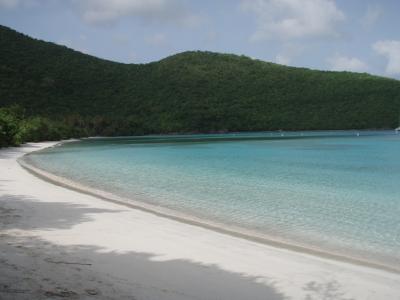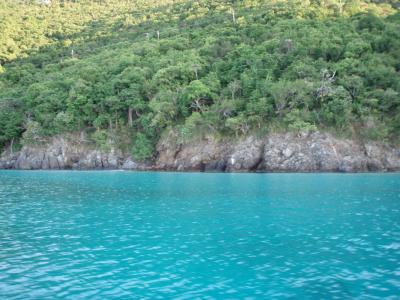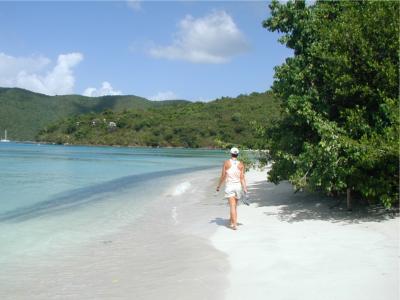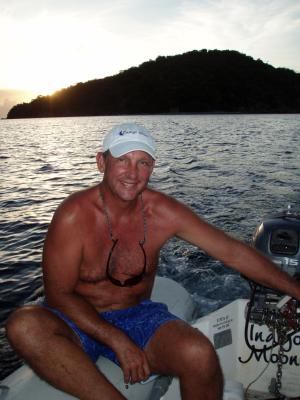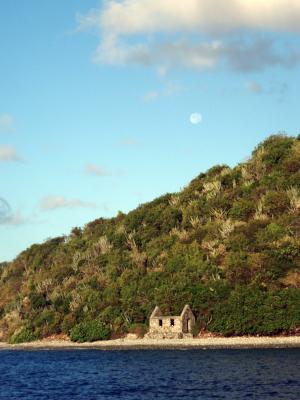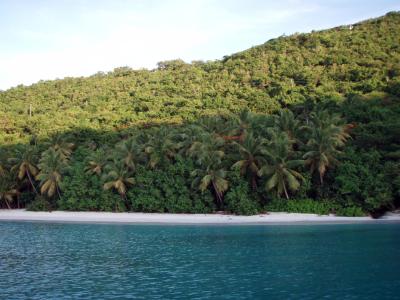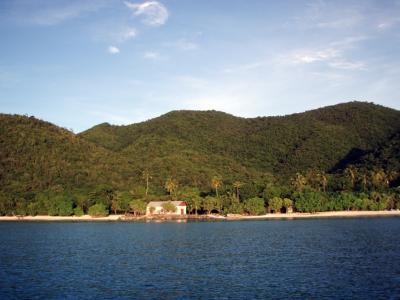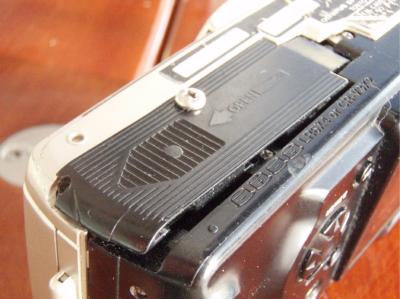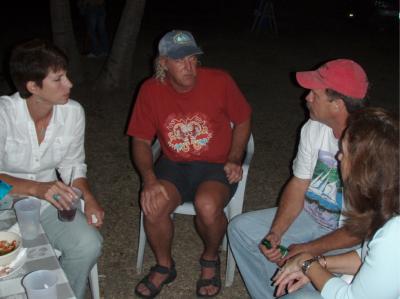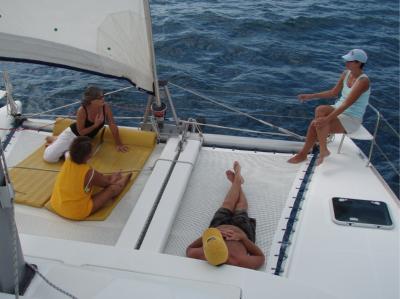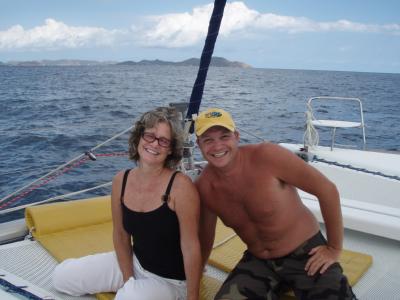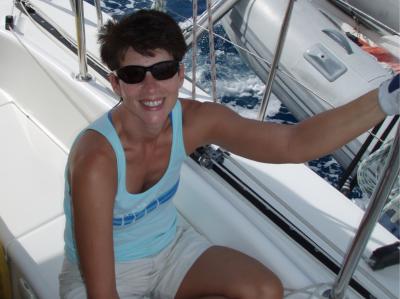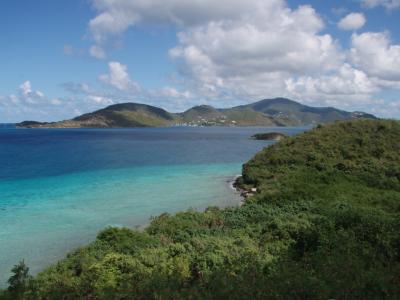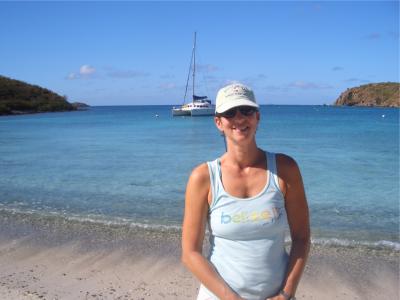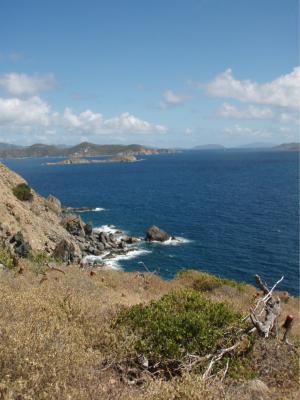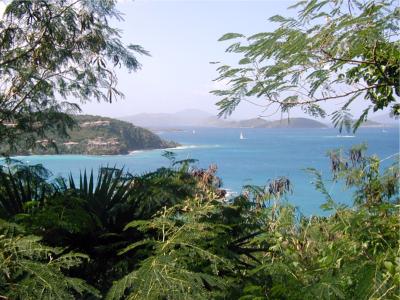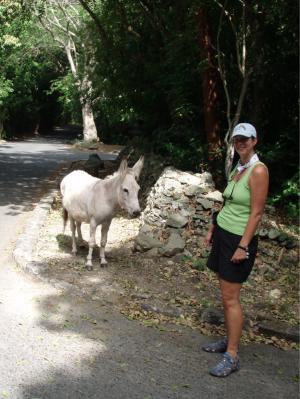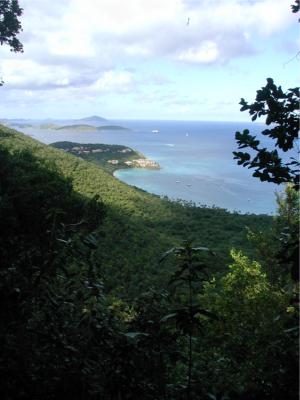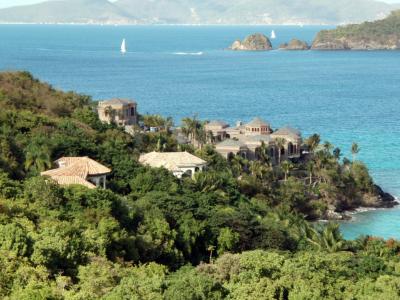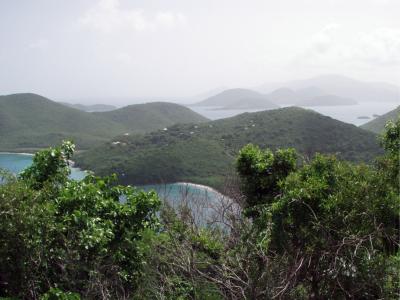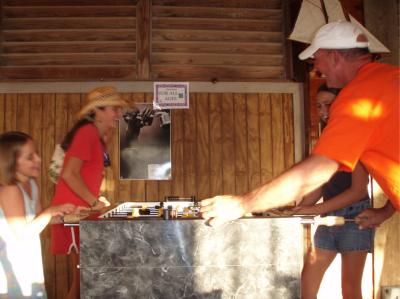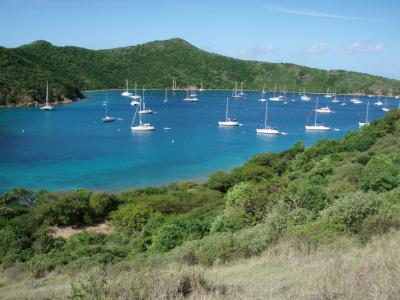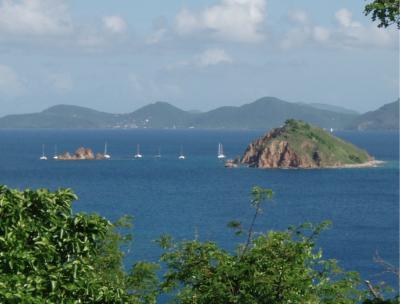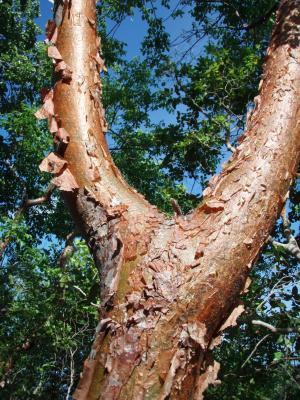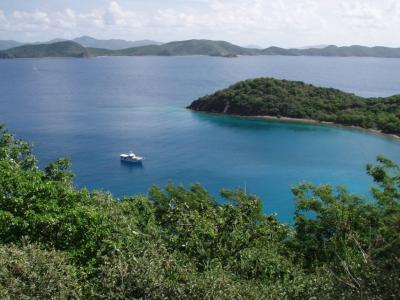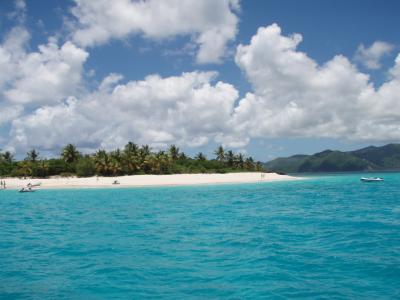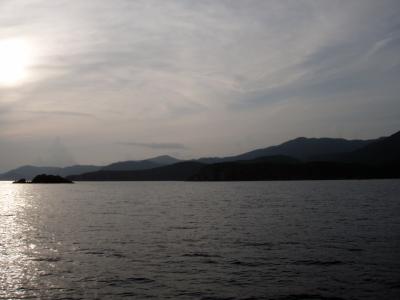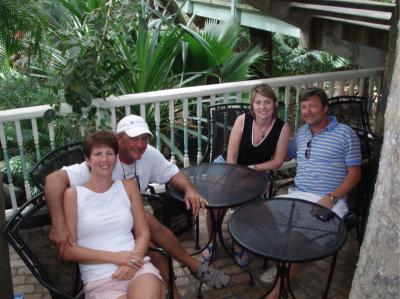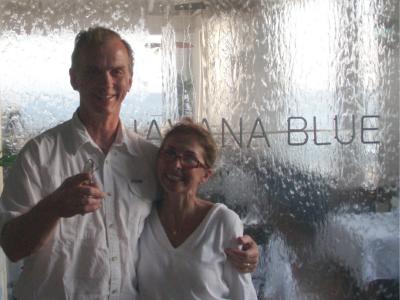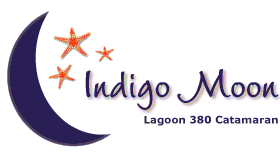
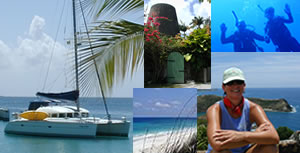
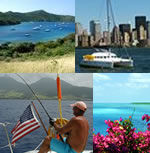
| |||||||||||||
When we left off last time it was November, near the end of hurricane season, 2006, and we were in Bonaire, one of the "ABC" islands off the coast of South America. Darkness had fallen as we continued to ready Indigo Moon for a two to three day passage from Bonaire to St. John, U.S.V.I. We needed to move in November to head north and beat the so-called "Christmas Winds" that kick up in December, making a direct crossing of the Caribbean much more difficult. Having received a “thumbs up” from professional weather consultant, Chris Parker, both catamarans Indigo Moon and Serendipity (our "buddy boat") were ready to head 42 degrees northeast to make a 420 mile non-stop crossing of the Caribbean Sea. As for the predicted weather, it was forecasted that the winds would get very light at least for one day, so a couple of drums of fuel were loaded aboard (I always like to have more than enough). We made one last trip to the grocery store and one last visit to the ice cream stand to spend all our remaining Gilders on ice cream and then headed to the boat; The outboard motor was removed from the dinghy and placed on a mount on the stern rail; The dinghy was raised and, using multiple lines, it was lashed to the davits and the transom cleat; The life raft was inspected; The ditch bag was thoroughly inventoried; New batteries were installed in all the backup handheld GPS units; The EPIRB was fully tested; New batteries were placed in our personal strobes; Our combination life jacket/harnesses and tethers were readied; Jacklines were rigged on deck so as to allow us to be tethered to the boat at all times as we move about the decks; Paper charts were marked with our intended course and every conceivable calculation: time; distance; fuel consumption (for each speed in half-knot increments ranging from 6 knots to 8 knots; GPS computer memory cards (chips) with C-Map cartography were inventoried and readied so that we could change cards when necessary. GPS cartography is accessed by the Furuno GPS unit from removable memory cards, much like the cards in small digital cameras these days; you need a different card for various major areas and we usually have to change cards when a distance of four hundred or more miles is covered in order to access the data from the new area; GPS waypoints were entered into the Furuno system via actual longitude and latitude coordinates derived from paper charts so as to ensure reliability; All engines, including the generator, were fully serviced and run, each being examined carefully (even with flashlight and mirror to see blind spots), for any operational abnormalities; The autopilot was tested in all modes; The radar was tested; I dove under the boat to clean all growth from the paddlewheel that measures boat speed through the water, said measurements needing to be accurate to detect current (by comparing GPS speed over ground "SOG" with the paddlewheel speed through the water display), and also for the autopilot to determine speed through the water and decide how aggressively it will adjust the rudders; A float plan was prepared and e-mailed to our sailing friend John Blackman in Baton Rouge. Melissa found a really nice electronic form that is a fill-in-the-blank template that provides a volume of information about your float plan; And finally, the sails were readied for raising and we were good to go. At this point, it should be evident that there is a BIG difference between readying a boat for an open ocean passage versus getting ready for a weekend of coastal cruising. Nonetheless, it is a labor of love and we have gotten very familiar with the routine and we accomplish things very quickly compared to when we first started out. In fact, many things about the operation of the boat seem so much easier now. I am fifteen to twenty pounds lighter for one thing. The Cruising Life is an active one. Also, there is no wasted motion now. Down to every turn and hitch of a line, I know exactly how I will lash the dinghy. All offshore preparation tasks have been repeated so many times now that there is no hesitation, guesswork, or “new ideas” to grapple with. We have finally landed squarely in the “comfort zone” of Cruising. By 19:00 on November 11th, 2007, we were ready. Both Indigo Moon and Serendipity dropped mooring lines at Kralendijk, Bonaire and motor-sailed in light winds northwest along the western shores of the island. The plan: as soon as we sufficiently clear the north end of the island, we will turn northeast. We have a waypoint set up 420 miles away just five miles south of Pillsbury Sound and St. John, U.S.V.I., and we are ready to access it. All we have to do is hit the “GO TO” button on the Furuno GPS which will in turn command the B&G autopilot to steer toward that waypoint. All set and drift is compensated for by the GPS and autopilot computers “on the fly” and continuously as sea and wind conditions change. Marine electronics are truly amazing. Nonetheless, we have our paper charts out, ready to be marked every three hours, and our paper log initiated to also be annotated every three hours with navigational data. We had already been warned that rounding the north end of Bonaire would not be a cakewalk. Currents and tradewinds accelerate around the more-mountainous northern topography of Bonaire. It was a suspenseful experience. It was pitch-black as we rounded the top of Bonaire. By watching the cartography on the GPS and looking at the wind direction, I knew we were nearing the position where we would be out from behind the lee of the island and exposed to whatever was “out there.” Quickly, the seas went from one to two feet to something much, much bigger! I could not see the waves, but Indigo Moon began bucking and clawing and slamming and our speed dropped from eight knots to five knots! Green water was flowing over the decks. Serendipity’s rail-mounted running lights were being completely consumed by spray every so often. Seen through binoculars, this created beautiful red and green fans of illuminated water that danced against the blackness. We were told that it takes at least fifteen miles to get clear of the island’s effects, so we crept along at five or six knots for five hours! Finally, the seas started laying down and over the following two hours all the drama was over. By the next morning, the Caribbean Sea was calm as could be. Our sailing angle was just a little too close to make good speed, so we motor-sailed, while the autopilot often steered up to 57 degrees magnetic in the westerly currents to keep us on a True course of 42 degrees toward St. John. We enjoyed a calm day at sea doing between seven and eight knots. So far we have not had to touch the autopilot. If the seas and winds remain this calm, we will make it straight to St. John without ever touching the helm or the GPS or the autopilot. As the day wore on, we../images/triplog/imgtr023 still could not believe that in less than two days we would be back in the Virgin Islands. As the sun set off our port aft quarter, we talked of all we planned to do and how much we love St. John, all while rejoicing in the calm conditions.
By mid-afternoon, the wind had laid down so much the jib would not stay set and we furled it. We were definitely in "motoring mode" now! It’s time to feed the Yanmar Diesels some more fuel! The Caribbean Sea might as well have been a swimming pool. The Yanmars sing a pleasant duet and push us at a little faster than seven knots and all is well.
Late afternoon, we crossed paths with a tanker headed south. The sea is so big it is hard to imagine that vessels find each other in close proximity, but they do. We made it across the bow of the tanker and he passed to our stern.
As the sun set on day two, I was very happy. So far, except for the four rough hours just off Bonaire, the trip has been just as predicted and it is virtually certain we will in fact make it straight to St. John and not have to deviate to Puerto Rico, etc. As night fell, Melissa took her watch from 18:00 to 24:00 without any drama. I took the helm at midnight and Melissa hit the rack. Soon into my watch, I was able to pick up NOAA weather radio out of Puerto Rico on the VHF! We had not had VHF weather for nine months! It was a treat, except that the forecast was scattered thunderstorms and a severe weather warning for Puerto Rico, not far to our north and northwest. I could see lightning to our north. I could see lightning to the south! Oh man! You know how I hate lightning! I listened to the VHF, scanned with the radar, chatted with Serendipity, and held my course. Still, no one has yet touched the GPS, or autopilot, or the wheel during the passage. I held my breath and crossed my fingers and prayed for a clear path through the storms. As is turns out, we saw no lighting come close, but we did hit a few squalls with winds gusting to 30 knots, with a "sailable" angle. So, I shook out the sails and sheeted in, doing over eight knots for several hours! The seas had not had a chance to build and the winds were far enough off our starboard bow to allow Indigo Moon to take off and really rip! By the time we neared St. Croix, some of the downpours were impressive. At one point I was looking at Serendipity’s running lights a mile away to my east according to radar. Still focusing on the radar, I watched a tight little squall gaining on them. Then, the lights of both Serendipity and St. Croix disappeared in the blackness of a downpour, all while my decks were bone dry. Within an hour, though, I got my share of rain too, and then it got busy with cruise ship traffic headed to St. Thomas! By dawn, the seas were building and the squalls were still blooming behind us. No matter, though, our ETA for St. John was only a couple of hours at this point.
Within an hour we were safely on a mooring in Caneel Bay on the northwestern shore of St. John. The sailing equivalent of “Beam me up, Scotty”, we could not believe our eyes! After eight and a half months of heading down-island, we were back “home” in U.S. waters. What a wonderful feeling! Volunteering for The U.S. National Park Service at St. John As soon as we recovered from our passage and were rested up, we stopped by the National Park Offices at Cruz Bay, St. John, and inquired about volunteering as a “Bay Host” for the Park Service. All of the bays on the north shore of St. John are within National Park Boundaries and anchoring is not permitted except in certain areas and for vessels over sixty feet. For vessels sixty feet and under, moorings have been installed. There is a $15.00 per night charge to anchor or use moorings. During the high season, the Park utilizes “Bay Hosts” to direct boaters to pay stations, hand out information, and to monitor activities in the various bays. We had learned about the Bay Host program last year after meeting Kendall, who was hosting Cinnamon Bay when we passed through on the way down-island. He explained that he got a free mooring and discounts at various businesses in exchange for hosting Cinnamon Bay for the NPS. Long story short, we met Andrea Joseph, director of the mooring fee program, and we volunteered to host beautiful Maho Bay.
After ferry trips to St. Thomas to obtain criminal background checks and to register Indigo Moon in the U.S. Virgin Islands, and a thorough Coast Guard inspection of Indigo Moon, we were approved as Bay Hosts. Quite frankly, we feel Maho Bay it is one of the most beautiful places on earth and we were ecstatic!
So, what exactly does the Bay Host do? Well, it’s simple. The moorings are free during the day, but between 5:00 p.m. and 7:00 a.m. it costs $15.00 to pick up a mooring. As such, Tuesday through Saturday (you get Sunday and Monday off) at 5:00 p.m. I began my rounds. The drill was as follows: I took a metal clipboard case with park pamphlets, pay envelopes and a mooring inventory sheet and idled the dinghy through the mooring field and anchorage writing down the name and home port of the vessels and what mooring number they were on (or if anchored). There are 28 moorings and there were usually only a dozen boats or so. Yachts over sixty feet must anchor farther out and still pay the fee.
It was my duty to survey both the mooring field and the anchorage. If people were on deck, I stopped and handed out pamphlets (with rules, maps, and general info), and also pay envelopes and directed their attention to pay stations (drop boxes) where they could deposit pay envelopes. The pay station at Maho is actually an old 25 foot Park Service vessel named the Beluga that is moored in the middle of the mooring field. People simply dinghy up to the side and deposit payments in the drop box mounted on the cockpit rail. It only took about fifteen minutes to complete my daily job. Usually by 5:20 I was back on Indigo Moon and my work day was over in less than half an hour total. The nice part is that I did not handle any money, or enforce any rules, or have any cross words with the general public. All I did was inform them about the Rules, hand out materials, and answer questions. When through with my rounds, I deposited my inventory sheets in the Beluga's drop box too and that’s all there was to it. In exchange, we got a free mooring for several months and also received a forty percent discount at the Maho Bay Resort restaurant and convenience store. Most important, boaters are limited to thirty days annually in the Park. But, as a Bay Hosts, we could stay up to six months! That is as good as it gets for Cruisers on a budget! All in all, it was an absolute joy to serve as Maho Bay Host and I met hundreds of interesting people. One thing that kept reoccurring was the weekend invasion of Maho Bay by Puerto Ricans on big sportfishing power boats. They like to raft up several boats on one mooring (against the rules). They like to tie up stern-to the moorings (against the rules). They like jet skis and pulling water skiers (against the rules). So, they kept patrolling Park Rangers busy. Also, the Puerto Ricans kept me busy too. More often than not, the Puerto Ricans would not have a dinghy or any way to go pay their mooring fee except by trying to back a giant sportfishing boat up to the Beluga as she danced around on a mooring. Not a good plan for the Beluga (she already suffered a few hits from big boats and so we tried to discourage any such attempts). I would explain that while I could not accept their money, I would be happy nonetheless to give a crew member a dinghy ride to the Beluga so they could make the payment themselves. One Friday evening, a particularly hard-drinking, festive crew of young and beautiful Puerto Ricans decided to send their shapeliest young female with me to make the mooring payment. As she stepped into the dinghy, it quickly dawned on me that the surface area of the dollar-bill-size payment envelope she had in her hand greatly exceeded the surface area of her entire bathing suit. Yep, she was a real live Latina version of Jessica Rabbit in the tiniest thong bathing suit I’ve ever seen. My jaw must have been resting on the dinghy gas tank. As we swung away, idling toward the Beluga, we made eye contact and she gave me the coyest little smile and cocked her head. In the most seductive of Spanish accents she quipped: “You know, if you don’t bring me back, they will come looking for you!” About that same time we passed right by Indigo Moon and I pointed: “Look, you see? That’s my wife waving at us. It is only fair that I must warn you too. If you seduce me she will come after you!” We had a great laugh. I found the Puerto Ricans to be a lot of fun. You never knew what you'd see next at Maho. One day a spectacular replica of an old sailing ship came in and dropped anchor. Turns out it was the Harvey Gamage, built in the early seventies and one of three school ships operated by the Ocean Classroom Foundation out of Rockland, Maine. What sight to see! She spent several days in and around St. John and I had the pleasure of greeting her at Maho Bay. Here is a link to the Harvey Gamage: Harvey Gamage
Other tall ships came and went too. While sailing to Tortola, we caught a glimpse of a tall ship under full sail headed northwest out to sea from West End. The Virgin Islands are the “ Atlanta Airport” equivalent of cruising and voyaging, and you see quite an array of various vessels of all shapes and sizes passing through during the cruising season.
As Bay Host I found myself in the strange position of commanding Captains of Mega Yachts to appear on deck and interact with me while on my rounds. Yes, I was very nice while handing out pamphlets and Park literature explaining that they could not water ski or wake board or jet ski or take twin outboard tenders into remote areas of the beach or any of the million other things that Mega Yachters live for. One Mega Yacht Captain said, as I showed him the literature: "Can I keep this pamphlet? The owner will not pay any attention to me and does whatever he feels like unless I show him something in writing that requires him to follow Rules!" Yes, there are Rules. Instead of a playground for egocentric Mega-Yachters, Maho Bay is a quiet, peaceful, no-wake zone and a terrible place to be if your mission is to whip out all your toys and show off while zipping around at 40 knots. That’s one of Maho’s best features – insulation from the typical "in your face" Mega Yacht invasion. Most of the Mega Yacht folks were well-behaved about it. On one occasion, however, I informed the Captain of a 100-plus foot monster yacht that the Rangers would ticket them for waterskiing. He turned around and announced it to the passengers and crew immediately as I departed. By the time I was a boat length away and looked back, several young women turned around, dropped their bikini bottoms, bent over gracefully and “mooned” me but good (this is when all good men put the outboard in neutral folks). I laughed out loud and gave them a wave, as I thought to myself: "Gee, they really know how to hurt a guy! I wonder what I would have gotten had I told them that both waterskiing AND beer drinking was prohibited in the Park!” But never underestimate the self-centered ingenuity of Mega Yachters when it comes to finding some way to be a nuisance to the general public. One afternoon at Maho Bay, Melissa and I were swimming in the shallows and talking with vacationers from all over and enjoying the peace and beauty when a big shiny new 80 foot power yacht pulled up very close to the mooring field and then motored into the mooring field and through it. Then the monster went just outside the mooring field and started spinning around and around, using its bow thruster to do so. This went on for twenty minutes! For those of you who don't know, bow thrusters are mechanisms mounted underwater and perpendicularly in the bow of larger vessels. A thruster has a tube that is part of the hull and open to the sea on both ends and has a propeller mounted inside that can be spun in either direction with the push of a button. The button controls a LOUD electric motor. By so doing, the bow can be pushed sideways at slow speeds and this is a great advantage in close-quarter docking situations and in cross-winds. The sound that bow thrusters make is like the sound of trying to put a John Deere tractor in gear without clutching it combined with the sounds that large tree limbs make when stuck into a commercial chipper - a horrible nerve-grating grinding sound that activates your "something's getting damaged" inner warning senses. As horrible as the bow thrusters sound, they work fine, BUT they draw huge amounts of electrical amps and are designed to be used in only small spurts to make small corrections and continuous use can damage them and burn them up! So what the Hell was wrong with this guy at Maho? Why was he destroying the peace and quiet of Maho for twenty minutes and trying his best to burn up the bow thruster? I wondered if the switch was stuck! Later in the evening, the new yacht was anchored at Maho when I made my rounds and I dropped by and handed out info to the Captain, who turned out to be a nice guy. After we chatted a while and got friendly, I asked him: "Hey Cap, what's up with all that bow thruster drama earlier this afternoon? Did you have a malfunction?" He got kinda red-faced and, rolling his eyes, he said: "No. That was the Owner at the helm. I told that stupid son-of-a-bitch he was making too much noise and was going to burn up the bow thruster too, but he's got so much money he doesn't care and he LOVES playing with that stupid 'effing' bow thruster. Sorry about that!" Cool Captain; jerk owner. That's pretty much the landscape in many cases. On yet another occasion, a cool Mega Yacht Captain asked me if I knew of a SCUBA diving service on St. John. A couple of welds failed unexpectedly and a two thousand dollar ladder parted from the transom of the big yacht and fell to the bottom fifty feet below! I informed him that there was no diving service that I knew of, but that I would get my dive gear and retrieve it for him. An hour later I returned and geared up. I took the end of a rope down with me. Within fifteen seconds at forty three feet, I found the ladder on the clean sand bottom– a massive, majestic design of chrome and teak. One quick bowline knot and I was done, heading up for a three minute decompression safety stop at 15 feet. Four and a half minutes after splashing, I was back in the dinghy with 2750 pounds of air still in the tank. A happy Captain insisted on sticking fifty bucks in my hand. Gee, fifty bucks for five minutes of work. That’s $600.00 per hour! That better than lawyer money! Too bad all I landed was five minutes worth the whole time we've been cruising. The point is that there was always “something going on” in or around the Park and it was never dull serving as a Bay Host. Maho Bay: Redefining “Idyllic” One of our favorite places in the world, Maho Bay deserves its own introduction.
The Bay is a wonderful home and habitat for many marine species. One night, at about 9:00 pm, I turned on the aft deck lights to raise the dinghy (I do this every night so that the bottom stays barnacle-free). I installed powerful lights on an aft rail of Indigo Moon so that we can finally handle raising the dinghy and perform other nighttime tasks at the stern without juggling a flashlight too. As I was raising the dinghy, something BIG caught my eye. The angled-down deck lights were illuminating the clean sand bottom only ten feet below. There it is again; WHAT IS THAT?! In a spilt second, I realized that a HUGE Tarpon was feeding on the small shiners hanging around in the subsurface shafts of light! Every few seconds, a Tarpon's side (way longer than a yardstick) would flash brilliantly. I called out to Melissa and she came up to see. As we looked around and took all this in, we noticed several round, dark shadows circling slowly near the surface just outside the field of light. Hmmm . . . Sea Turtles maybe? I swiveled one of the deck lights to illuminate one of the shadows: it was a spectacular specimen of the Spotted Eagle Ray, gliding effortlessly just under the surface and with 2 inches of each wingtip out of the water and pointing straight up. There were three Spotted Eagle Rays milling around and about a half-dozen Tarpon. Wow, what a cool "backyard" we have here at Maho Bay! We didn't leave the lights on too long. The Park literature suggests that deck light use should be kept to a minimum to protect sea turtle hatchlings. Yes, Maho Bay is a magical place. Now that we have all those great sunshades I manufactured with my Sailrite sewing machine while marina-locked in Venezuela, we have been lounging on the trampoline in the breeze and cool shade, reading books and enjoying front-row seats at the "Maho Bay Wildlife and Cruiser Show." Perhaps a pelican has just hit the water, literally three feet from the bow of the boat, and I tilt my book down and turn my attention to it -- so close I can pick out sharper details than you can get from an Audubon painting. I study their habits. If they have a fish in their bill, they always wag their tails as they slowly drain their bills and then cock their heads back to swallow their catch. Or maybe there is a school of fish directly under the trampoline, performing synchronized ballets. Or better yet, every once in a while a little foot-long spanish mackerel performs an air strike. Working solo at full speed, the mackerel will launch out of the water at a long, low angle designed for distance. Hitting the water a good twenty feet away from where he launched, the mackerel splashes down into a school of little silverside minnows that, in turn, instantly jump and do their best to remain airborne until the attack is over. Further, it is intriguing to study the mackerels' movements during these assaults. They keep "swimming" while airborne. With tails pumping at full speed against the air, they resemble mechanical bathtub toys. Or as I am reading, or drifting in free-thought toward a nap, it is not at all unusual to hear the faint breaths of one of the dozens of sea turtles nearby, replenishing their oxygen supplies prior to a new dive, or perhaps a 30 minute nap (they actually can hold their breath and nap that long on the bottom). At Maho, it's not just the sea that mesmerizes. Rainbows seem to have been invented here: the most strikingly brilliant and the most frequent of any place on earth that I have ever been. Double rainbows are not uncommon at all. On bright sunny days, small rain showers drift over the mountains. The deep green of the lush mountains and the bright sun serve to perfectly reveal the inner workings of each little shower: wind currents, rain density and patterns in the sheets of rain. The intense beauty here at Maho Bay is almost too much for the soul to take. I sometimes felt as if we snuck over a fence while the Gods weren't looking and were absolute trespassers, frolicking in the backyard of Heaven. Of course, this also gave us the sensation that at any moment the Gods might come out on the porch and "run us off the property." In short, we were keenly aware of the fact that we were extremely lucky to be able to stay in Maho Bay and the Virgin Islands National Park area for so long. Lets look at some pictures to bring all this together:
It was as good as it gets: reading away in the shade on the trampoline, and at any given moment I might turn my attention away from authors like Greg Iles, Nathaniel Philbrick, and Patrick O’Brian to watch the "Maho Show." And while the days were truly mezmerizing, so were the nights. As fate would have it, a Leonids meteor shower occurred on November 19, Melissa's Birthday! We spent the evening on a mooring at Cinnamon Bay and at about 10:00 pm we took blankets and pillows out to the trampoline and laid on our backs and looked up at the stars. Sure enough, the shooting stars began appearing and in less than an hour we were able to count 42, one for each year of Melissa's Birthday, plus one more to grow on. Considering that the majority of St. John is undeveloped National Park, there is very little ambient light and stargazing is very satisfying in the north shore bays. Living in remote areas, on land or sea, means the night sky becomes much more a part of your overall awareness. One evening while moored in Maho Bay, I went out on deck at about 9:00 pm to clean a cooking pan, or do some other chore, and it immediately struck me that there was something "wrong" with the sky! It was a full-moon night and had been very bright earlier, but things were disconcertingly dim. Good Lord! When I looked up there was a lunar eclipse in full swing! It was really dramatic when viewed from the deck of a boat in the middle of a dark anchorage surrounded by blacked-out mountain peaks. So, add "Perfect Planetarium" to the already weighty list of St. John's desirable attributes! Maho Bay "Ecolodge" Resort Wholly unobtrusive and barely visible from the mooring field, the Maho Bay Resort has rooms situated on the hillsides on the eastern end of Maho Bay. The rooms are really not "rooms" at all. Instead, small stand-alone screen houses are scattered about the hillsides under the canopy of mature trees. The rooms are connected by a network of wooden stairs and walkways that run from beach level, all the way up to the registration desk, convenience store and open air restaurant 120 steps up from the beach. The restaurant overlooks Francis Bay and offers wonderful sunsets.
Maho Bay Resort guests enjoy hiking, swimming, snorkeling and sailing Hobie cats and Sunfishes at the beach. Also, there is a glass blowing facility. A show is conducted five nights a week and visiting experts from Vermont create all sorts of spectacular pieces while the audience “oohs and ah's.” Beer bottles are recycled on the property and melted and used to blow the glass pieces. Also, pottery and other crafts are created and guests can sign up for classes.
The glass blowing sessions were fun to watch and part of the entertainment was to try and guess what was being made as the piece was shaped more and more. All of the pieces were completed and then placed in a computer-controlled oven that would slowly decrease the temperature overnight so as to allow the artwork to cool gradually and not shatter. By the next day, the creations would be for sale in the store by the restaurant. Cool! Maho Bay Neighborhood Although Indigo Moon remained on a mooring in Maho Bay, we would often explore the nearby beaches and small islands by dinghy or kayak. Here are a few photos of the 'neighborhood'.
2006 Thanksgiving and Christmas Holidays at St. John, U.S.V.I. This would be our first Thanksgiving and Christmas in the tropics proper, amidst true summer-like weather conditions. Even as far south as Ft. Lauderdale last year, there were a few mornings of “sweater weather” during the Holiday season. Not so in St. John. We would be in summer temperatures and bathing suits the whole time! We ate Thanksgiving dinner at the Maho Bay Resort with several cruising friends. A hundred locals augmented the crowd of resort guests and it was wonderful to eat a traditional Thanksgiving dinner with no dishes to wash!
We had fun decorating Indigo Moon with Christmas lights.
We even had nice Santa Hats and Buddy took to wearing his while making rounds as Bay Host.
By the time Christmas rolled around, several of our buddy-boating friends had made it to St. John. Catamarans Serendipity, Evensong, Pirates Hideout, and Maker’s Match were there. Also, monohull Fidelis arrived. We were all in the spirit of the Holiday Season, with Christmas lights on our boats, etc. The Lucia Girls created their traditional Ginger Bread house, but their customary construction methods of using icing for adhesion of joints proved inadequate in the tropical heat. The roof kept sliding off! So, they had to add candy cane pillars to support the overhangs on the roof. Also, just to get into the spirit, Rachel wore a sweater when they made their rounds in the mooring field to show the gingerbread house. They visited all the boats and sang Christmas Carols. Those Lucia girls . . . I tell ya! They are the cat’s pajamas!
And it was time to make plans for Christmas Dinner! Melissa and I sure liked the ease of simply walking up the steps at Maho, just as we did for Thanksgiving. But, a few others were willing to try and stage a traditional Christmas Dinner on the beach and that became the consensus. And so it began: who will go get turkeys and when? Who will cook "this" and "that" and what will we use for a table on the beach? What time? How many? Should we invite "this" boat and "that" boat?” Where exactly on what beach? Sounds carefree and easy, right? Maybe. Cruisers by nature have become pretty independent, though. So, deciding on the simplest things as a group sometimes becomes a great undertaking of the day. There are VHF conferences wherein various ideas are floated out ever so gently. There are usually a few strongly opinionated and controlling types (like me) involved, but all of us will only go so far as to lightly suggest ideas, always ending with, “but it really does not matter – we’ll do what everybody else wants to.” It is proper Cruising etiquette: “Well, instead of eating dead lizards on a stick with doo-doo sauce at the roadside stand, Melissa and I would probably prefer to go to a real restaurant, but we’ll do what everybody else wants to do, and dead lizards will be fine if someone feels strongly about it.” Then there are those who wait it out and offer no opinion during the VHF conferences. They are smart and fly under the radar. They know that the uncontrollably strong-willed in the fleet will present all the options anyway. These smart Cruisers always adhere unwaveringly to, “we don’t really care, so whatever you guys decide.” Of course, talk to them later and they will spill their guts: “Oh God, Buddy! Thank You! We were so relieved when you had the guts to speak up in opposition to the eating dead lizards with doo-doo on a stick idea. Yuck! I can’t believe “so and so” wanted us to do that! They are nuts! And so it was for Christmas Dinner negotiations at Maho, luckily the options were all good, though and there were no "doo-doo"' type suggestions. With enough diplomatic and logistical considerations to put on a Rock & Roll Show in Baghdad, the plans were in place. The following boats would participate:
and, of course
For a buffet table on the beach, we used five gallon buckets to support Evensong’s teak grate gangplank. To get the gangplank to the beach, Steve on Evensong and I spanned it perpendicularly across our dinghies and motored in. All available kayaks were also towed in to use as barriers to “rope off” a little section of beach for our private party. Beach chairs, umbrellas, it all kept coming like the Normandy invasion. Then, Serendipity Girls Rachel, Marcie and Jillian stood watch and guarded the area, lest tourists show up and think the kayaks and chairs and umbrellas are public property. And it’s a real threat. We often beached our dinghy at Maho to go hiking. More often than not, upon our return, we would find that beachgoers were sitting in and on the dinghy, wet and covered with sand. The dinghy would be full of beach bags and gear, and sand. We would have to evict the public and spend awhile cleaning all the sand out (there is no worse enemy than sand and you don’t want it in your boat, on your clothes, etc). And so the stage was set. The only thing that could demolish Christmas Dinner at this point was a bad rainstorm, etc. Luckily, it was a “Blue Bird Day” and everything went off without a hitch! We all enjoyed a wonderful dinner, swam in the turquoise shallows and sang Christmas Carols. It was a strange yet wonderful experience spending Christmas in bathing suits on the beach in 86 degree weather! Here is a look:
And so, what did Santa Claus bring us for Christmas here on Indigo Moon? A new digital camera! As it was, our old friend that we had used almost exclusively was a goner. People have always raved about our photos, expecting that we use terrifically professional gear. Truth is, Melissa has a very nice Olympus 8080 “big” digital camera that looks like a 35mm SLR and has something like 8 megapixel resolution (as you all know, the higher the mega pixel number, the sharper the resolution and thus the more you can enlarge and crop photos with them maintaining sharp clarity and not becoming “pixilated” – blurred into individual little squares called pixels). But, the big camera is bulky and conspicuous and a hassle to carry around casually. It’s expensive, a lot to lose, and risky to carry on the streets in many areas. It’s not waterproof either, making it impractical for many boat tasks, wet dinghy rides and nautical tasks that invite all things to be marinated in salt water. Thus, while the “really nice” camera had spent the last three years of its life being protected and hidden below, ninety-nine percent of all the photos you’ve enjoyed on our website came from a bashed, battered and abused Olympus D-490 camera with only 2.4 megapixel resolution. I think toy cell phones have cameras with higher resolution nowadays. Anyway, the poor thing had been dropped on the deck a few too many times, springing the casing. The case would not stay closed all the way and that caused a loose connection somewhere making the camera go “dead.” So, I put it in a vise, ever so carefully, and epoxied the seam to make if tight again. Eight more months of service! Then, the little door that closes the battery compartment lost its plastic tabs that slide into the case and keep it shut – they just plain wore off. So, without the benefit of MRI’s or X-rays, or even a “camera anatomy” chart, I took a deep breath and drilled a hole through the door and into the camera so as to be able to use a self-tapping stainless sheet metal screw to shut the battery door and hold it fast. I must have missed all “brain matter” and it worked -- we got another six months of service! Then, finally, something went permanently awry. The camera would “eat” four AA batteries overnight while turned off. So it was time. We asked Santa Claus for a new “everyday” boat camera. Technology has advanced so much in five years. We got an Olympus 720SW, a much higher resolution camera with 7.1 megapixel resolution. It is shock and drop-proof for up to a 5 foot fall, waterproof (not resistant mind you but “proof”) to ten feet deep and even has underwater settings for snorkeling. It is half the size of the old Olympus and really is a “Pocket” camera in that it is the size of a deck of playing cards. It’s got much more capacity, and it operates much faster and seems to have been designed for the rough, tough, wet world of cruising. Here's a link to the Olympus website if you want to see the camera: Olympus Stylus 720SW I have already tested the camera's durability by crashing my bicycle and using the new camera as a “skid pad” under my right palm as it hit the asphalt hard and slid a good way with my weight on it. The camera got a few scratches but it still works perfectly and is still waterproof. Anyway, I could not seem to bring myself to throw the old camera in the garbage and I kept it for posterity. Here it is:
Now back to the Holiday Season! In addition to Christmas Dinner and a new camera, I also got a real cool Birthday Party! I was born on December 29th and, as a result, Birthday parties have been hard to come by during my 51 years of life. Worn out from the Holidays and with money tight, during the week after Christmas most folks are resting up for New Year’s and "coming down" from the emotional trip of the big build up for Christmas Day. Understandably, no one is ever up for a “blow out” Birthday Party much less buying yet another present for somebody on December 29th! As you know from prior reports, by this time we had celebrated several Lucia family birthdays while in the islands off Venezuela. The Serendipity Girls knew my birthday was coming up and I told them about my plight of not getting many parties in my life due to the timing of my birth between two major holidays. Well, they immediately decided they were going to make up for all the “lost” Birthday parties. Yes, they love me! It was awesome. They made banners, cards, had gifts, and made a custom sailboat birthday cake too. Steve and Sue on catamaran Evensong made their way back to Maho Bay for the event as well. We all ate cake and ice cream until it was coming out of our noses. We danced, sang, and had the best of times! It was a great Birthday Party and the Serendipity Girls are truly wonderful. Here is a look:
For a birthday present, Melissa gave me a glass blowing lesson at the Maho Bay Resort. The beginning lesson is a thirty minute hands-on primer that teaches the basics and during which I created a rose bloom and a starfish. It was fun and provided a good understanding of just how difficult the art is. Here is the step-by-step photo journal:
It was quite fun, and quite HOT. I enjoyed learning some of the basics and certainly honed my appreciation for the skillful glassblowers at Maho. We made many visits and watched them create spectacular pieces of art during the months we were Bay Hosting and living just off the beach from the resort. In addition to glassblowing exploits, Melissa took a class in pottery making.
Cruising means saying Hello to New Friends while saying Good-bye to old ones It is a natural part of Cruising that close friends come and go, and often unexpectedly. The Cruising life is precarious anyway. Any one of a million things can cause a major change in Cruisers’ itineraries, either suspending or ending altogether the dream of Cruising. Nature took its course while we spent several months at Maho Bay. It was not long after the Holidays that Jeff Lucia, aboard catamaran Serendipity was contacted and offered a job in Shanghai, China! Jeff is an Oracle Database wizard and they needed him to help design systems for the China Stock Market (big-time stuff!), making an offer he couldn’t refuse. He accepted. Damn! My cruising friends have been Shanghaied, literally! And so it was a very tearful and heart wrenching day when Jeff, Pam, and the Serendipity Girls Rachel, Marcie and Jillian sailed north, headed for Florida. Once in Florida, they began to make arrangements to store the catamaran and move their daughters, two cats and one dog to China in a very short time period! The Lucia's are enjoying many interesting experiences in China. We have kept in touch with them via e-mail and await the day we get to be reunited somehow. Hopefully the catamaran Serendipity will again sail into the harbor and drop anchor a stone’s throw away. We miss them terribly. As old friends move on in this Cruising life, new friends are made. And sometimes old friends reappear out of thin air. While moored in my usual spot in Maho Bay one calm morning, Melissa and I were in the salon just hanging around and all of a sudden Indigo Moon started spinning quickly as if caught in a wild whirlpool! I bolted out of the salon door into the cockpit to try and comprehend what in the world was happening only to find our old friend George Huffman and Cliff Cooper (who we had not met yet) in a dinghy, nose to Indigo Moon’s stern and using the outboard to push hard on her and spin her on the mooring like a top! And there was George, “grinning like a possum” and laughing while watching my facial expressions as I went through a three-second transition from utter confusion and disbelief to complete understanding that I was a victim of rascality. George made the Gulf of Mexico crossing with Melissa and me on our initial departure from New Orleans to Marathon in the Florida Keys. As fate would have it, George was crewing on an Island Packet sailboat making the “I-65” trip from Florida to the BVI. They just happened to pull into the neighboring Francis Bay and spotted us with binoculars. We got to see even more of George later in the week and met him, Cliff and several other new friends for dinner one night at Latitude 18 at Red Hook harbor on St. Thomas.
While in Maho bay we also enjoyed meeting Mike and Terri Hubbard, Minnesotans aboard the fantastic Manta 42 catamaran MT Nest. Mike is a professional saxophonist among other things and he routinely stands on his bimini top at sunset and serenades the anchorage with delightful tunes. Also, while Melissa was on a trip home, Terri took pity on me. She’s a great cook and they had me over for real turkey dinner and all the trimmings, taking in a “boat bachelor” who had been eating peanut butter and jelly for days on end.
Also, Dave and Sue MacKay showed up on Manta 42 Pirates Hideout. We had met them briefly when we were coming down the east coast, in Ft. Pierce. It was Sue and I who saved the little dog caught in the current. Anyway, in that old trip report, I incorrectly referred to the boat as Pirates Hideaway! YIKES! Dave informed me that a “hideaway” is where people go to get massages and sleep on lace pillows and attend conferences on self-help and meditation! Pirates, by God, are tough and they use HIDEOUTS! So let’s set the record straight! It is Dave and Sue on Pirates Hideout!!! More new friends also appeared in Maho. One afternoon a 45 foot Leopard catamaran's crew picked up a mooring right next to us. Soon thereafter Robert and Jennifer Whitton swam over to introduce themselves. They live in Hawaii and, unbeknownst to us, have been reading the Indigo Moon website for some time. They decided to take catamaran sailing lessons in the BVI. And what do you know? By pure chance, on their first night in the Virgin Islands they picked up a mooring right next to us! Although exhausted from their travels from Hawaii and their first day aboard, they came over to Indigo Moon to visit us after dinner. How cool is that!?
And the Whittons were not the only folks to recognize the Indigo Moon. While walking at Bitter End, a nice lady stopped me, spotting my Indigo Moon hat: “Hey, you’re Buddy right?! My husband (a fellow Lagoon 380 owner) reads your website all the time!” Also, a stranger broke into a VHF conversation of mine one day to ask if I was the Lagoon 380 Indigo Moon with the website. He thanked Melissa and me for the website and all the inspiration that it has provided him and his wife. So, while we surely do not produce the website for the purpose of recognition, it was very nice to receive kind words and compliments from the “yachting public” in the Virgin Islands and to know so many people from all over the world share the dream and appreciate following our adventures. We still receive e-mails and inquiries from literally around the world. It is amazing that the simple tales of Indigo Moon have spread so far and wide. On a different front, we were in St. John for so long that we actually had the pleasure of becoming quasi-locals of the island and it enabled us to get to know many local people on a level that simply can’t be attained while on the move and cruising. I got involved with a local group of people living and working on St. John and met many wonderful people including Jim Cross who resides on St. John and operates his own renovation and construction business.
Jim is an avid diver and underwater photographer and Melissa and I had a great time hanging out and SCUBA diving with him. He has a cool Sea Ray runabout that makes quick work of trips out to French Cap Island (an unexpectedly awesome dive spot about five miles south of Red Hook Harbor at St. Thomas). Here are some shots of Jim's underwater camera work:
Also, through Jim, we met local artist Catherine Perry. She has built a spectacular home that overlooks the Coral Bay and Hurricane Hole areas of East St. John. The project is called “House of Open Arms” and is comprised of several independent outbuildings including a villa and cottage, all of which can be rented. It really is a charming island getaway with breathtaking views and we would highly recommend it. Catherine is a very friendly and interesting person who makes her guests feel welcome and at home. If you see her, tell her we said hello. Here is a link to the “House of Open Arms” website: House of Open Arms We spent a wonderful evening at House of Open Arms with Catherine and Jim Cross, enjoying spectacular vistas, a wonderful BBQ dinner, and conversation of the finest kind. Also, one day we took Jim, Catherine and yet another new friend, Georgeann, for a day sail around the entire island of St. John. It was so calm in the morning we actually saw a whale spout! Whales migrating from the North Atlantic during the Spring months are often seen around the Virgin Islands. What a wonderful life we lived at St. John with many friends and a feeling of connection with the local community that Cruisers on the move rarely experience.
Hiking the Trails of St. John The azure waters and unparalleled beaches of St. John are often so alluring that week-long vacationers understandably can’t imagine turning even one second of their attention toward the inland features of St. John. Almost eighty percent of the island is undeveloped and protected U.S. National Park, the land having been donated by Laurence Rockefeller. There are numerous hiking trails up and over various areas of the mountains of St. John, offering awesome vistas, great exercise and a natural beauty that challenges the senses so much so that you find yourself rubbing your eyes and taking a second look just to make sure it isn’t a dream. Trails we liked include Cinnamon Bay, Johnny Horn, Ram Head and the Annaberg Plantation Ruins, all with interesting attributes. Annaberg Plantation Easiest hiking is to the Annaberg Plantation Ruins, considering paved roads lead to the site. Located several hundred feet above the shore on the northeastern end of St. John, the plantation ruins overlook Sir Frances Drake Channel and the British Virgin Islands to the east: an amazing vista that lives up to everyone’s daydreams of what the West Indies looks like in the mind’s eye. Preserved for inspection are the ruins of the old windmill’s base, the grinding yard where horses were used to grind sugarcane as well, and the boiling room where various sugar pots were arranged and plumbed to allow processing various grades of product. Slight remnants of slave quarters remain.
Circa 1721, Annaberg was one of two dozen active sugar, molasses and rum plantations on St. John and still operating as late as by 1780. Danish owner, William Gottschalk, named the place “Anna's Hill” after his daughter. The operation was an unthinkably harsh undertaking: slave labor was used to clear dense, prickly scrub forest that had been toughened by the trade winds. After clearing the un-clearable, the hillsides and slopes were terraced to accommodate the planting of sugarcane. All of this by hand in the searing West Indian sun. Predictably, like all other sugar operations in the West Indies, when slavery was abolished, such plantations became unfeasible, not only because of the end of cheap labor, but because the thin layers of soil had been exhausted. Today, placards with artist’s renderings depict the entirety of the operation, with whole mountainsides cleared of brush and sugarcane being cultivated on narrow terraces across the mountainside.
Utterly impenetrable vegetation has reclaimed the mountainside and it appears flatly impossible that any such plantation ever existed. But it did. Directly north of Mary’s Point on St. John is a narrow passage of sea less than a mile wide (aptly named “the narrows”) with Great Thatch Island of the British Virgin Islands lying on the other side. Annaberg Plantation is located on Mary’s Point. The British abolished slavery on August 1, 1834 . The Danish abolished slavery on July 3, 1846. As a result, from 1834 to 1846 and for almost twelve years, there was a tremendous incentive for slaves on St. John to swim the narrows to freedom in the British Virgin Islands. Guard facilities were constructed near Annaberg, overlooking the narrows and from which swimming slaves would be spotted and caught.
Overlooking the entire area, and taking all this in, is quite disturbing. Slave-driven sugar farming in the Danish Virgin Islands stands for a legacy of terrible human atrocities and it is unfathomable as to how any human soul, no matter how callous, could commit such cruelty in such a beautiful place on earth. The United States purchased the Danish Virgin Islands in 1917. And so, there is much more to hiking on St. John than a mere physical journey. St. John’s history commands an emotional journey on the trails as well. Every trail on St. John challenges the mind with history and accounts of intense human dramas that played out on this beautiful island, always offering small puzzle pieces of why things are the way they are here today. Also, providing insight into what the future may hold for St. John. Johnny Horn Trail Per the book “ St. John off the beaten path”: The Johnny Horn trail was named after Johan Horn who was second in command to Governor Gardeline in St. Thomas and Commander of St. John at the time of the 1733 slave rebellion. Small plantation owner and Englishman John Charles said of Horn: “He had a grimace for a face, lies for eyes, noes for a nose, arse cheeks for face cheeks, fears for ears, whips for lips, dung for a tongue, and to all that knew him it seems strange he had but one horn for a name.” The Johnny Horn trail connects Leinster Bay (at Annaberg on the north side of the island), with Coral Bay on the south side of the island, where the historical Emmaus Moravian Church is located. The Johnny Horn trail is only 1.8 miles long, but climbs to 400 feet before descending back to sea level on each end. For us, the Johnny Horn trail required dragging the dinghy up on the beach at Francis Bay, hiking to and past the Annaberg Plantation first, and then starting the Johnny Horn trail at Leinster Bay and arriving at Coral Bay for a long rest. Then, it is all the way back to Maho on the same route! The Johnny Horn trail has several sections that are incredibly steep and it’s not the first trail you want to try! It is definitely one we worked up to. Coral Bay is the one area in St. John where cruisers can anchor for free and without park fees and regulations. Thus, it is a natural hangout for the entire spectrum of the cruising society, from active cruisers passing through on seaworthy vessels to desperate bums/drunks living on wrecks that will never set sail again. Skinny Legs Bar and Grill caters to the Cruiser Crowd and it is the epicenter of the Coral Bay cruising scene. Also, just down the road, the Donkey Diner is a favorite Coral Bay place for breakfast. Melissa and I decided to hike the Johnny Horn trail one Saturday morning early, eat breakfast at the Donkey Diner, and then hike back.
Once over the top of the mountain, we can see Coral Bay.
We’re hot, tired, thirsty and hungry, so the first stop is the Donkey Diner for breakfast consisting of juice, omelets and toast.
Coral Bay is a true cruisers’ hangout and there are many sights that reflect the mischievous minds of cruisers with lots of time on their hands. Here are some sights from around Coral Bay:
Now, back to our Johnny Horn hike . . . . It was quite a morning and we got an extra bonus: the running of the annual St. John “8 Tuff Miles” marathon was underway. The foot race begins in Cruz Bay, on the western end of St. John and ends at the east end of the island at the Coral Bay soccer field. Runners traverse the steep grades and winding switchbacks on the North Shore Rd., crossing the entirety of the mountains of St. John. After eating breakfast, we walked fifty yards over to the soccer filed to watch runners coming in, including several locals that we are now friends with.
Ram Head Trail Also, another favorite hike is Ram Head on the south side of St. John. Rugged, trade winds-beaten, and overlooking St. Croix and the Caribbean Sea to the south, this hike offers stunning views. There is scant vegetation and few trees, so it is a popular hike during a full moon in that the trails are perfectly visible under the light of a bright moon. Basically it is a solid rock peninsula, and scientists have examined core samples of Ram Head and determined it to contain the same material that comprises the ocean floor. Thus, experts have concluded it is the oldest rock formation on the island and that no other rock formation on St. John predates it. Desolate, its history includes being a hiding place for runaway slaves who “marooned” themselves on this desert-like peninsula. Cactus grows here and provided fresh water to the marooned slaves. Also, Ram Head was a stronghold for the Akwamu tribesmen who staged the 1733 slave rebellion. It is said that when the tables turned and the rebellion was quelled, many of the tribesmen committed suicide, leaping off Ram Head rather than face being captured. St. John is about eight miles wide and about as long on average. It’s a small area, relatively speaking, and it seems every square yard has hosted some form of conflict. The more you learn, the more you begin to comprehend that St. John’s early history is solely woven with the cloth of slavery. St. John’s history really is overpowering; a dumbfounding juxtaposition of the absolute worst of Human Nature and the absolute best of Mother Nature.
Cinnamon Bay Trail The Cinnamon Bay trail begins at Cinnamon Bay and climbs up the mountain to Centerline Road at the top. Centerline Road is the main highway that connects Cruz Bay and Coral Bay, traversing the peaks of St. John. Back in the plantation days, the Cinnamon Bay trail was a donkey trail which followed a natural drainage gut. Because of the gut, this trail is rather lush compared to many St. John hikes and provides welcome shade. It also offers fabulous views of Cinnamon Bay. It was quite common for us to beach the dinghy at Maho and walk up the North Shore road to Cinnamon Bay and then up the Cinnamon Bay trail from there. Usually it took us about and hour and a half to walk from Maho beach to Centerline road. Sometimes when we reached Centerline Road. we would catch the bus to Coral Bay and have lunch. Here are some of our favorite photos from the hikes:
During one of our Cinnamon Bay hikes, we came upon a wedding in progress at the beach. There are many, many weddings on the beaches of St. John all season long. Just so happens that the minister in blue robes is Anne Marie Porter who performed our marriage ceremony ten years ago!
Caneel Bay: Still a Very Special Place Of course, for us every trip to St. John includes a visit to the Caneel Bay Resort on the northwestern shore of St. John. We were married there on Turtle Point in 1997 and the resort is still the magical place for us that it was back then. We enjoyed walking around the grounds and reminiscing about all that we have enjoyed and endured during the last ten years of marriage and we always find Caneel Bay the perfect place to bring forth emotions of quiet reflection and humble thanks for the wonderful life we live.
Also, while strolling around, I actually caught a Mongoose on film. They are shy, fast and very hard to photograph, but I caught one with his beady little eyes afire from the camera’s flash!
We strolled around Caneel for a couple of hours and thoroughly enjoyed the sights. Although it was not open that early in the morning, we were invited in to take a few photos of the Equator Restaurant, which is located in a renovated old Sugar Mill. Here’s a look:
Taking a Break to Visit the British Virgin Islands: We also made several trips to the B.V.I.’s during our season at St. John. My duties as a volunteer Bay Host did not prevent Melissa and me from enjoying the B.V.I.’s too. Maho Bay and Francis Bay are actually part of one huge bay. Our neighboring Bay Hosts, Randy and Bonnie on Dreamaker are great friends and we worked together to relieve one another now and then. As Bay Hosts, we all had Sunday and Monday off anyway, but if we wanted longer times off, we would simply ask Bonnie and Randy to cover both bays. The Park Service was happy as long as the surveys were done and the rounds were made. So, when Dreamaker had guests and wanted to go sailing for a week, we would reciprocate and I covered both bays, etc. On one of our trips, we visited Bitter End Yacht Club again and saw Ft. Lauderdale’s Pam and Andy Wall during women’s sailing week. Also, Wayne and Millie Buras from Covington, Louisiana, showed up on their catamaran Honemeaux. We had a lot of fun! Manta 42 Pirates Hideout, with Dave and Sue MacKay came that way too and we enjoyed eating dinner with them at Cooper Island Beach Club and hanging out at Bitter End. Sue even participated in some of Pam Wall’s sailing classes, how cool is that!
On the way to Bitter End from Cooper Island, it was pretty “sporty.” Dave was motorsailing with the jib while we sailed with no engines. Here are some pictures of Pirate’s Hideout in the seas:
Melissa and I had a romp of a sail to Bitter End, even tacking far out into the Atlantic in big seas to make the layline to the entrance of North Sound on Virgin Gorda, where Bitter End is located. Not long after we arrived, Wayne and Millie Buras from Covington, Louisiana, came in on their catamaran, Honemeaux. One night Millie cooked red beans and rice for us and, I swear, I had to try not to cry it was so good. What a wonderful treat, and it is always great to see Wayne and Millie.
We also had a fabulous time seeing Pam and Andy Wall again as usual, and Andy (an expert rigger) was nice enough to come out to Indigo Moon and take a quick look at our rigging and make sure we were in good shape (and we were!). Melissa and I also enjoyed hiking at Bitter End. It was a nice vacation from Maho (boy, that sounds silly -- like we of all people really need a vacation).
Toward the end of our time at St. John we made another round through the British Virgin Islands. Our first stop was Norman Island, which is has a large protected harbor known as the Bight. Normal Island also has some good hiking trails sporting gorgeous views of Sir Francis Drake Channel and Norman Island bays. The island is the supposed setting for Robert Louis Stevenson's Treasure Island and has a documented history of real pirates and buried treasure. Knowing the history of the island, it's fun to imagine stumbling upon some treasure while hiking.
After our night at Norman Island, we snorkeled at the Indians and then sailed over to Sandy Cay where we had lunch on the boat.
We spent one night at Cane Garden Bay, anchoring between the mooring field and the beach. There is actually a strip of sand bottom that is 15 feet deep and one of the few places you can anchor easily in shallow water in the B.V.I.; most bays are too deep, or the mooring fields cover the entire area and obstruct anchoring spots. When we anchored in Cane Garden Bay this time, there were probably ten boats in the bay, not coming close to filling the fifty or so moorings. I set the hook and we settled just a little closer to one particular mooring than I would have liked. But, there were ten open moorings all around us, so there was not much chance anyone would pick that one, right? Well damn! Here they come! A Moorings 3800 catamaran motored directly to the mooring we anchored a little bit close to. After three tries they grabbed the mooring line. Then, they all came forward to tie up the boat (two men and two women). The guys worked on a bizarre plan for securing lines to the mooring while their wives watched. Thirty minutes later, they were done: with long lines tied to the mooring, diminishing our swing room further. The whole scene screamed: first time on a charter, first time on a catamaran, first time in the Virgin Islands and, perhaps, the first time on a boat! The winds were very light and as the sun began heading for the horizon, and we still had enough room to be fine once the boats settled in. Having anchored hundreds of times, I was comfortable that there was nothing to really worry about.
The sun began setting and Melissa and I decided to go to shore for dinner and had a nice meal while watching the sunset over Cane Garden Bay.
After dinner, we had a nice walk on the beach and everything was wonderful when we returned to the dinghy and made our way back to Indigo Moon. We could see the boat the whole time we were ashore and all was well. It appeared we would have a peaceful evening. Just as we stepped onto Indigo Moon, our neighbors came by in their dinghy, returning after about six hours at the beach bars. I went about my usual routine of hoisting the dinghy on the davits and securing things and then Melissa called my attention to the fact that our neighbors were leaving! This is strange! The Moorings forbids the night operation of vessels. The cut into Cane Garden Bay is not something you want to undertake at night unless you are very familiar with it. So what are they doing? With my aft deck lights brightly illuminating the Moorings 3800 catamaran, I saw it heading past our port side doing 4 knots and gaining speed fast. Then, I noticed IT WAS STILL TIED TO THE MOORING! One second later, I saw the catamaran gain another knot or two before bringing the mooring line taut. The boat dipped its bows very hard, stopped, and then still under power it slowly turned and began heading TOWARD US! GOOD GOD! Now we have a catamaran, piloted by drunken fools, that is tethered to a mooring ball and will go around in a circle like a model airplane on strings – and we are very close to being in that circle! That’s the one thing I didn’t figure on! My heart was pounding and I had a split-second decision to make: 1) run for the helm and crank up our engines and run full ahead toward our anchor; or 2) try screaming at the people to stop the boat. Screaming was risky, but quicker. I managed to scream and convince them they were moving and to stop their engines, which they did. They swung around and missed us by a boat length. The guys were stumbling drunk and loud and indignant and announced they were charging the batteries and what was my effing problem!?! The wives were quiet and embarrassed. Once the drama was over, we watched the wives try and untangle the mess of ropes cinched tight by the force of stopping a 20,000 pound catamaran doing six knots! The drunk guys "helped out" by turning on the running lights, steaming light, deck light and anchor light and then they left all the lights on and passed out and went to sleep. We bugged out at dawn and there they sat, still with every light on.
From Cane Garden Bay we went to West End to meet up with friends coming in on Lagoon 410 Mama Cocha. They had just made the arduous trip from South Florida to the Virgin Islands.
Also, while in the B.V.I., Melissa and I decided to motor to Anegada (the drowned island). We had already been there once, years ago on a Moorings charter. It was a flat-clam day. We anchored far from the pack and had a walk around and then a lobster dinner at Neptune’s Treasure, the local tourist trap. It was ok, but Anegada is still out least favorite place in the Virgin Islands and we re-confirmed it.
It was time to check out of the BVI and return to the USVI so we made our way to Customs and Immigration in Spanish Town on Virgin Gorda. In the middle of the afternoon, the door was locked during hours it was supposed to be open. It was Spanish Town that a gentleman gave us such a hard time a year ago when we were departing for St. Martin and heading south. Turns out, that really mean guy is now dead! His heart attacked him. He was so legendarily hated that fellow cruisers in line were laughing and cheering after someone came along and informed us about the guy's death. Tough crowd. Turns out the new Customs Officer is a woman. She finally wandered slowly up the street mid-afternoon waving her hands with fingers spread out, obviously having just emerged from getting a manicure. We were finally checked out and on our way after a three hour wait.
LIFE as a quasi-resident of St. John: Laundry, Shopping, Fuel, Ferry Wakes, Surfing in the Dinghy, Crime and other exciting stuff Familiarity breeds contempt and St. John is not immune. Although the natural beauty of St. John’s Maho Bay is unparalleled, from a logistics standpoint it was less than convenient to live there. Shopping required leaving our mooring at Maho Bay and motoring 40 minutes west along the north shore of St. John to Caneel Bay to pick up a mooring there. Then, we had to take the dinghy a fairly far piece, a mile or so, around a point in open waters of Pillsbury Sounds into Cruz Bay to the dinghy dock. Cruz Bay is a very busy ferry port, with numerous LARGE ferries leaving for all points in the B.V.I. and St. Thomas all day and as late as midnight. They ride close to the mooring field in Caneel Bay and put out severe wakes that make all tasks difficult, whether dropping the dinghy down, loading things in and our of the dinghy, riding around the point into Cruz Bay, or trying to simply not get soaked. The wakes are so big that more things have fallen off shelves and onto the cabin sole of Indigo Moon in Caneel Bay on a mooring than on any offshore passage to date. Yes, Caneel Bay is a “War Zone” for cruisers trying to get to Cruz Bay and take laundry to shore, buy fuel, get groceries and pick up the mail, etc. Once ashore, the best market in Cruz Bay requires a fifteen minute walk inland up very steep hills. Laundry had to be carried up those same steep hills. Both laundry and all groceries had to be carried back down the steep hills, all in 90 degree heat. You could not help but think about what working in sugarcane fields was like in these conditions.
Although it was “work” we routinely took a lunch break at Mongoose Junction, where a resident chicken seemed to always insist on supervising the dining area from over my shoulder.
Considering I was not willing to give up my lunch, the chicken decided to muscle-in on the local cat’s lunch. It’s a jungle out here!
After lunch, it’s back to work. Fuel for the boat to run the generator and gasoline for the dinghy required either taking the big boat into the fuel dock, or taking several five gallon jugs to the fuel dock in the dinghy (an hour undertaking, start to finish either way). Basically, about every two weeks, we had “Hell Days” where we would "suck it up" and head to Caneel Bay for a solid two days of misery to accomplish all necessary tasks to “reload” and head back to Maho Bay for two or three more weeks of splendid living. Not a bad tradeoff, but still, I came to hate the Cruz Bay reprovisioning drill.
Also, we made two trips to Charlotte Amalie, the main port of St. Thomas, anchoring out and doing major provisioning at big stores like Home Depot, Super K Mart, Price Right and Cost-U-Less supermarkets. When we first arrived from Bonaire, we shared a rental car with Serendipity and bought out the stores!
Now back to Maho. Aside from the tough provisioning routine, we also found ourselves challenged by swells and high surf warnings now and then. The north shore of St. John is exposed to the Atlantic Ocean, and while trades blow from the east and the bays that cut into the island are mostly protected from prevailing winds, the bays are wide open to northerly swells that sometimes come in. These swells, generated by storms and cold fronts hundreds of miles away, wreak havoc. There are no dinghy docks at Maho Bay, Cinnamon Bay, Trunk Bay, or Hawknest Bay, etc. The only way ashore is to beach the dinghy and drag it up on the beach. When big swells come in, there is no safe way to shore (except swimming). One evening we decided to dinghy in and eat dinner at the Maho Bay Camps. The swells were running a bit. I stood off the beach, idling and waiting to head in between sets of swells, but my timing was awful and I managed to catch the biggest wave of the night! The wave crested and broke!. The dinghy caught the wave, went sideways and then vertical. I leaned hard to try and keep it from flipping, all while looking back and tending the outboard engine as well, trying to get it turned off and tilted up before it hit bottom. I managed to keep the boat from capsizing and when the wave finally retreated, the dinghy spun out on the beach, left high and dry. I looked around and THERE WAS NO MELISSA! She had fallen out and went totally under when we first got caught by the wave. She was now in waist-deep water, her nice clothes soaked, and her favorite earrings dripping, all oozing the “drowned rat” look. I said nothing and spun the dinghy around and pushed it out into the next wave that arrived a second later, cranked the engine, collected Melissa on the way out and we went back to Indigo Moon. I swear, the whole ordeal, from walking off the boat to returning, probably took five minutes. We rinsed out our clothes, took showers, ate scrambled eggs and toast and hit the rack. Visitors aboard The Moon in the Virgin Islands We had the pleasure of enjoying the company of Chris and Trula Remson for a few days. They are becoming “frequent fliers” on Indigo Moon having visited us in the Bahamas, Martha’s Vineyard, and now St. John. We took a break from Bay Hosting and showed them around St. John, including Maho and Cinnamon on the north side and Lameshure and Salt Pond on the south side, with hikes on Cinnamon and Ram Head trails. As always, it was a pleasure having them aboard!
Also, we entertained Michael and Debbie Holleman of Gulfport, Mississippi. Mike is a dear friend of mine, a practicing “Miss’sippi Law-yuh” and was just recently married to a beautiful lady, Debbie. Katrina wiped out his home in Gulfport. In the midst of all that, he and Debbie never got a chance to go on a honeymoon. So, they came to see us! We had a great time and they commented that they had never been on such a laid-back perfect vacation.
As fate would have it, we were in St. Thomas, bringing Mike and Debbie there to catch their plane home when we got a call from Melissa’s brother, Dennis. Melissa’s Dad had a heart attack and was in the process of being prepped for open heart surgery. Melissa's father was the primary caregiver for Melissa’s Mom who had been fighting liver cancer for seven years and was not expected to live much longer. Luckily, Aunt Barb was there when Dave had the heart attack and Aunt Barb could care for Melissa's Mom until we arrived. We were already scheduled to fly to Baton Rouge in three weeks for a two month visit. But now time was of the essence. We made arrangements to have the boat hauled out at Nanny Cay Boat Yard on Tortola, B.V.I., a yard very familiar with all catamarans and where the Catamaran Company (the Lagoon dealer) bases their charter operations in the B.V.I. The yard manager, Keith LiGreci, is a prince of a guy and he had us hauled in two days.
In just two days, we managed to put Indigo Moon in long-term storage mode (a feat to pull off in a week, much less two days), and were on a jet bound for Baton Rouge before we knew what happened! From March 5th to May 15th, 2007, we spent days and nights helping to care for Melissa’s parents: her Dad was fighting to recover from quintuple bypass surgery all while her Mom was slipping away. Melissa’s Mom passed away on April 23, 2007, at home with all of us at her bedside and under the guidance of Hospice Care (we cannot in words adequately express our gratitude to the St. Joseph’s Hospice organization – amazing services provided by some of the most fearless and compassionate people we have ever met). Melissa’s Dad recovered and by the time we left he was physically fit, but he may never fully recover from the loss of his wife of fifty years – his sweetheart since the time they were childhood neighbors in Corcoran, California. It was a completely shattering, heartbreaking time for Melissa’s family. We returned to Nanny Cay with heavy hearts. And what awaited us next? How could we cheer ourselves up? Well, hmmm. . . how about returning to jump right into the annual checkbook-bashing, ball-breaking annual maintenance routine on ndigo Moon!? YEAH; that's the ticket! : bottom job, waxing, sail drive servicing, and a long list of various “out of the water” tasks. After a week of working full days in a 100-plus degree heat index environment, I was a zombie, but there was an upside: I had quickly lost the extra 10 to 15 pounds I had put on while eating my way across Baton Rouge for two months. There was ice cream by the gallon; fast food that tastes better than anything at any price in the Caribbean; breakfast lunch and dinner out almost everyday with friends and associates, all while eating amazingly huge portions of irresistibly good food. Supermarkets full of absolutely obscene inventories of fresh foods that we had missed for years. It was easy to eat like I had just been released from a Caribbean Culinary Prison and I went at it like there was no tomorrow! Back in Nanny Cay, the day finally came, though. With the bottom painted, the hulls and underbelly of the bridge deck buffed and waxed to perfection, and the sail drives serviced and painted, we were ready and splashed Indigo Moon. We could not wait to resume our cruising life and be back on the boat in pretty water, relaxing once again.
We splashed, cranked her up and motored from Nanny Cay around to West End and picked up a mooring. Dog-tired yet ebullient about finally being home again, we settled in for the evening: showers, dinner and into the bunk with clean sheets. We both exhaled and reflected on the last couple of months and how great it was to be back on the Moon. Just then, after literally only ten minutes of lying there, Melissa sat straight up in bed with a horrible look on her face: “I feel a lump in my breast! I don’t believe this! We are finally back home AND NOW THIS!!!” Sure enough, it was unmistakable: a pea-sized hard lump. . . . . and so, rest and relaxation "disappeared over the horizon" again. In the next week, Melissa conferred with her Baton Rouge OBGYN, Dr. Randall Brown, by phone. His gut reaction was that it was probably nothing, but that it needed to be investigated if we were to have peace of mind. So, it was “pack a bag and back to Baton Rouge” for Melissa while I stayed on the boat for a week on a mooring in Maho Bay. Melissa had a lumpectomy and the offending mass was removed and was benign. In the meantime, during her absence I caught a nasty stomach-flu of some sort and spent a night hurling in a bucket and moaning in painful isolation aboard Indigo Moon. Yes, it seemed we had all fallen into an abyss of some sort and our luck was so utterly down. But, by the time Melissa returned, I was back to normal and we were both ecstatic that she was ok. But we were beat both physically and emotionally. And so, we were behind the "eight ball" and found ourselves in the beginning of hurricane season and still in St. John. We decided to head south ASAP and sail straight across the Caribbean Sea from St. Croix to Bonaire. We planned to spend the majority of the Hurricane Season in Bonaire and envisioned heading back to the Virgin Islands again for yet another season in paradise as Maho Bay Hosts next year. We will pick up next time as we hop down to St. Croix and ready Indigo Moon for yet another offshore passage straight across the Caribbean Sea. Stay tuned!
If you would like to receive an e-mail notifying you of updates to the web site, subscribe here. |
|
![]()




























